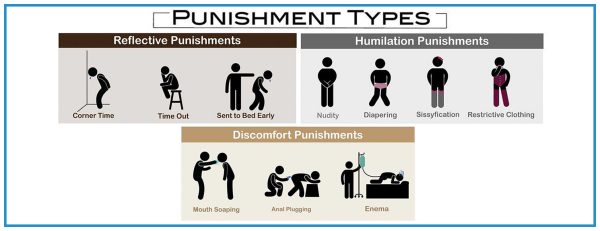Looking to take your dominant-submissive relationship to the next level? Our comprehensive guide will teach you how to master the art of punishing your submissive with ease and confidence.
BDSM relationships are all about power dynamics and mutual consent. As a dom, it's your responsibility to set boundaries and ensure that your submissive partner respects them. One of the most effective ways to do that is through punishment.
Punishment is a powerful tool for maintaining control and enforcing rules in BDSM. But it's also important to understand that it should always be carried out with consideration for the sub's well-being.
In this guide, we'll teach you how to master the art of punishing your submissive in a safe, consensual, and effective way. Are you ready to become the ultimate dominant and take control of your BDSM relationship? Keep reading.
Understanding Punishment in BDSM Relationships
In BDSM, punishment is the application of a negative consequence for a sub's failure to follow orders. It reinforces the power dynamic between the dominant and submissive partners.
It's rooted in the concept of consensual power exchange. This is where the submissive willingly relinquishes control to the dominant. Punishment plays a key role in maintaining this dynamic. It provides a means for the dominant partner to give commands both of the partners enjoy and approve.
Common misconceptions about punishment in BDSM
There are common misconceptions about punishment in BDSM relationships, too. These can lead to misunderstandings and even harm. Some of them are:
Punishment is a means of abu.se
This is not true in healthy BDSM relationships. Ideal partners who respect each other only use punishments to fortify rules. It's a consensual way to maintain the power exchange they want. Punishment is always physical or sexual.
Yes, physical and sexual punishments are common in BDSM relationships. But they are not the only forms available. There are other effective means to control and enforce boundaries. Such are verbal reprimands, withdrawal of privileges, and other non-physical forms of punishment.
Punishment is all about the dominant's pleas. re
This couldn't be further from the truth. Consensual BDSM punishment requires clear communication, mutual understanding, and respect for boundaries. Failing to uphold these key principles can lead to serious emotional and physical harm. Some can even cause lasting damage to the relationship.
Types of Punishments
Right communication and techniques enhance BDSM partner's connection. They can even take the dominant-submissive relationship to the next level. There are many different techniques and tools when it comes to BDSM punishments.
Here are some of the most common types of punishments in BDSM:
Physical Punishment
Physical punishment involves inflicting pain or discomfort on the submissive partner to discipline. Spanking, caning, and paddling are all common forms of physical punishment. It's crucial to establish clear boundaries and safe words first. This is to ensure that the dominant doesn't go overboard and the sub feels trapped.
Psychological Punishment
Psychological punishment involves words or actions to inflict emotional pain on subs. This can include humiliation, verbal abuse, or degradation. It's important to ensure that the sub is comfortable with the level of psychological punishment applied. The dom should also always focus on the submissive's welfare.
Sensory Deprivation
Sensory deprivation is a BDSM technique that limits one or more of the sub's senses. It's usually through blindfolds, gags, earplugs, or hoods. This enhances the other senses, making the experience more intense. It's critical to ask the sub if they're willing to deprive a part of their senses before doing the punishment.
Time-out and Denial
Time-out and denial involve withholding attention, affection, or sexual gratification. This can be orgasm denial or having a time-out period where subs can't interact with their doms. It's key to have clear rules beforehand to carry out the punishment in a fair manner.
Factors to Consider Before Punishing Your Submissive
Doms can't just go ahead and carry out a punishment out of the blue. Remember that punishments should fit your sub's offense. Plus, it's unfair to withhold your attention and ignore your sub because they refuse to do a kink. Punishments are not meant to force subs to do something they aren't comfortable with.
Here are some of the key factors to keep in mind:
Ensuring Clear Communication and Consent
Clear communication and consent are essential to carry out punishments based on agreed terms. Discuss the punishment beforehand to ensure both you and your sub know what it involves. Determine the type of punishment and level of intensity.
Then, agree on any safe words or signals to pause or stop the punishment. To be sure, some partners decide to write up a BDSM contract.
Discussing Boundaries and Limits
Go through both of your boundaries and limits with your submissive partner. Talk about what types of punishments are acceptable, what the submissive is comfortable with, and what is off-limits. Doing this ensures that the punishment still respects the sub's needs and desires.
Assessing the Physical and Emotional State of Your Submissive
Evaluating your sub's physical and emotional state is a pivotal step you should never skip. If the submissive partner is not feeling well or is emotionally fragile, it's not appropriate to carry out the punishment. As a dom, it's your responsibility to be aware of your sub's needs. You should also always prioritize the sub's physical and mental health.
Effective Punishment Techniques
Punishing your submissive means balancing maintaining control and securing consent and safety.
Here are some tips for delivering a punishment effectively:
Be Clear and Consistent
Before carrying out a punishment, be clear and consistent about what you expect of your sub. Talk about the rules and boundaries you both set. Then, remind your partner of the consequences of breaking them. Finally, ask your sub if there's something they didn't understand or need clarification for.
Being consistent with the rules and limits reinforces their importance.
Use Positive Reinforcement
While punishment is often associated with negative consequences, it can also be a tool for reinforcing positive behavior.
For example, you can reward your submissive for following the rules by offering praise or affection. The next time you punish your sub, they'll follow more easily as they think of the reward that comes after. It will also create a more positive dynamic between the dom and sub.
Balance Punishment and Aftercare
Aftercare is an essential part of any BDSM dynamic. This is especially true when it comes to punishment. Aftercare involves providing emotional and physical support to subs after a punishment to calm or soothe them. It may be in the form of reassurance, cuddling, or giving them food or water.
By balancing punishment with aftercare, the submissive partner feels supported and cared for.
Dealing with Resistance to Punishment
Even in the healthiest BDSM relationships, there may be times when a submissive partner resists punishment. Here are some strategies for addressing non-compliance:
Understand the Reasons Behind Resistance
Before addressing non-compliance, it's important to understand the reasons behind it. The sub may be experiencing physical or emotional discomfort, may feel that the punishment is unfair, or may simply be feeling overwhelmed.
Communicate Freely
Open communication is key when dealing with resistance to punishment. Encourage your submissive partner to communicate their feelings and concerns. You should also be willing to listen and adjust the punishment if necessary.
Adjust the Punishment
If your submissive partner is resisting a punishment, it may be necessary to adjust it. You can reduce the intensity of the punishment, change the type of punishment, or even cancel the punishment altogether. Be flexible and willing to modify the punishment as needed to respect your sub's state and feelings.
Seek Outside Help
If resistance to punishment persists, try seeking outside help or advice. You can talk to a therapist, join a BDSM support group, or look for guidance from other experienced practitioners. Remember that seeking outside help is not a sign of weakness.
It's rather a sign of strength and commitment to maintaining a healthy and fulfilling BDSM dynamic.
Summary
It's important to remember that BDSM is all about consensual power exchange and mutual respect. Punishment can be a powerful tool in reinforcing boundaries and maintaining a healthy dynamic between doms and subs. But it would be best if you approached it with care and consideration.
Before administering any form of punishment, effective communication and clear consent are key. Understanding your partner's physical and emotional state and respecting their boundaries and limits are also crucial factors to keep in mind.
Remember that punishment is not just about discipline. It can also serve as a means of positive reinforcement for good behavior. When used correctly and with balance, it can help to build trust, deepen intimacy, and strengthen the bond between partners.
So, to all those exploring BDSM relationships, remember that punishment is not about control or abuse. By following the right techniques and strategies, you can create a safe and fulfilling dynamic that truly embodies the essence of BDSM.



























